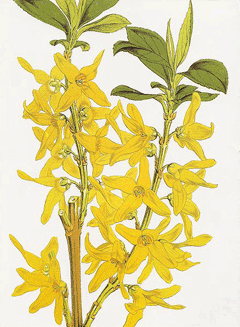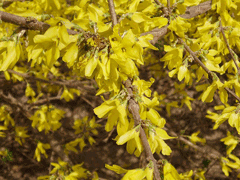 |
|
http://commons.wikimedia.org/wiki/File:Forsythia_viridissima_RHS.jpeg |
 |
| http://commons.wikimedia.org/wiki/User:Fanghong |
Translate this page:
Summary
Bloom Color: Yellow. Main Bloom Time: Early spring, Late spring, Mid spring. Form: Rounded, Spreading or horizontal.
Physical Characteristics

 Forsythia viridissima is a deciduous Shrub growing to 2.5 m (8ft 2in) at a slow rate.
Forsythia viridissima is a deciduous Shrub growing to 2.5 m (8ft 2in) at a slow rate.
See above for USDA hardiness. It is hardy to UK zone 5. It is in flower in April, and the seeds ripen from August to November. The species is hermaphrodite (has both male and female organs) and is pollinated by Insects. The plant is not self-fertile.
Suitable for: light (sandy), medium (loamy) and heavy (clay) soils, prefers well-drained soil and can grow in heavy clay soil. Suitable pH: mildly acid, neutral and basic (mildly alkaline) soils and can grow in very alkaline soils.
It can grow in full shade (deep woodland) semi-shade (light woodland) or no shade. It prefers moist soil.
UK Hardiness Map
US Hardiness Map
Synonyms
Plant Habitats
Woodland Garden Sunny Edge; Dappled Shade; Shady Edge; not Deep Shade;
Edible Uses
References More on Edible Uses
Medicinal Uses
Plants For A Future can not take any responsibility for any adverse effects from the use of plants. Always seek advice from a professional before using a plant medicinally.
Antibacterial Antifungal Antispasmodic Emmenagogue
The fruit is antibacterial, antifungal, antispasmdic and emmenagogue[279]. It is used in Korea to treat carbuncles, mastitis, inflammation, suppuration, lymphadenitis and suppressed menstruation[279].
References More on Medicinal Uses
The Bookshop: Edible Plant Books
Our Latest books on Perennial Plants For Food Forests and Permaculture Gardens in paperback or digital formats.

Edible Tropical Plants
Food Forest Plants for Hotter Conditions: 250+ Plants For Tropical Food Forests & Permaculture Gardens.
More

Edible Temperate Plants
Plants for Your Food Forest: 500 Plants for Temperate Food Forests & Permaculture Gardens.
More

More Books
PFAF have eight books available in paperback and digital formats. Browse the shop for more information.
Shop Now
Other Uses
Landscape Uses: Border, Erosion control, Ground cover, Massing.
Special Uses
Food Forest
References More on Other Uses
Cultivation details
An easily grown plant, it succeeds in all soil types[202] but prefers a rich soil. Succeeds in limey soils. Grows well in heavy clay soils. It prefers a sunny position but succeeds in semi shade though it is apt to get leggy if grown in the shade of trees[182]. Succeeds against a north-facing wall[219]. Plants are hardy to about -25°c[184]. Plants are medium to fast growing[202]. Flowers are produced on wood that is more than one year old[202]. Any pruning is best done immediately after the plant has finished flowering[182, 200]. There are some named varieties, selected for their ornamental value[11, 200]. This species is notably susceptible to honey fungus[200]. Special Features:
Attractive foliage, Not North American native, Blooms are very showy. In garden design, as well as the above-ground architecture of a plant, root structure considerations help in choosing plants that work together for their optimal soil requirements including nutrients and water. The root pattern is fleshy. Thick or swollen - fibrous or tap root [2-1].
References Carbon Farming Information and Carbon Sequestration Information
Temperature Converter
Type a value in the Celsius field to convert the value to Fahrenheit:
Fahrenheit:
The PFAF Bookshop
Plants For A Future have a number of books available in paperback and digital form. Book titles include Edible Plants, Edible Perennials, Edible Trees,Edible Shrubs, Woodland Gardening, and Temperate Food Forest Plants. Our new book is Food Forest Plants For Hotter Conditions (Tropical and Sub-Tropical).
Shop Now
Plant Propagation
Seed - sow spring in a cold frame. The seed usually germinates within 2 months[K]. When they are large enough to handle, prick the seedlings out into individual pots and grow them on in the greenhouse for at least their first winter. Plant them out into their permanent positions in late spring or early summer, after the last expected frosts. Cuttings of half-ripe wood 10 - 15cm taken at a node, July/August in a frame. Plant out in autumn or spring. A very high percentage, they root within 3 weeks[78]. Cuttings of mature wood in a sheltered outdoor bed. Good percentage[78]. Layering in spring or summer. Plants often self-layer[K].
Other Names
If available other names are mentioned here
Native Range
TEMPERATE ASIA: China (Anhui Sheng, Fujian Sheng, Hubei Sheng, Hunan Sheng, Jiangsu Sheng, Jiangxi Sheng, Yunnan Sheng (northwest), Zhejiang Sheng), Korea
Weed Potential
Right plant wrong place. We are currently updating this section.
Please note that a plant may be invasive in one area but may not in your area so it's worth checking.
Conservation Status
IUCN Red List of Threatened Plants Status :

Growth: S = slow M = medium F = fast. Soil: L = light (sandy) M = medium H = heavy (clay). pH: A = acid N = neutral B = basic (alkaline). Shade: F = full shade S = semi-shade N = no shade. Moisture: D = dry M = Moist We = wet Wa = water.
Now available:
Food Forest Plants for Mediterranean Conditions
350+ Perennial Plants For Mediterranean and Drier Food Forests and Permaculture Gardens.
[Paperback and eBook]
This is the third in Plants For A Future's series of plant guides for food forests tailored to
specific climate zones. Following volumes on temperate and tropical ecosystems, this book focuses
on species suited to Mediterranean conditions—regions with hot, dry summers and cool, wet winters,
often facing the added challenge of climate change.
Read More
Expert comment
Author
Lindl.
Botanical References
11200266
Links / References
For a list of references used on this page please go here
Readers comment
| Add a comment |
|
If you have important information about this plant that may help other users please add a comment or link below. Only comments or links that are felt to be directly relevant to a plant will be included. If you think a comment/link or information contained on this page is inaccurate or misleading we would welcome your feedback at [email protected]. If you have questions about a plant please use the Forum on this website as we do not have the resources to answer questions ourselves.
* Please note: the comments by website users are not necessarily those held by PFAF and may give misleading or inaccurate information.
To leave a comment please Register or login here All comments need to be approved so will not appear immediately.
|
Subject : Forsythia viridissima
|
|
|
|